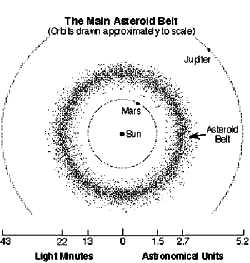A quiver full of asteroids
 More dangerous than all the nuclear weapons of the world put together are these bombs in outer space. Huge rocks which form a crude circle between Mars and Jupiter in a part of the solar system known as the asteroid belt. There are 300,000 asteroids larger than 90 metres wide and some of them come perilously close to the Earth's orbit. Each could inflict the damage more than a Hiroshima-sized nuclear bomb.
More dangerous than all the nuclear weapons of the world put together are these bombs in outer space. Huge rocks which form a crude circle between Mars and Jupiter in a part of the solar system known as the asteroid belt. There are 300,000 asteroids larger than 90 metres wide and some of them come perilously close to the Earth's orbit. Each could inflict the damage more than a Hiroshima-sized nuclear bomb.
However, the asteroid tracking programme is cash-strapped. The US National Aeronautics and Space Administration (NASA) spends only US $1.8 million on it every year. If one of the asteroids is found to be dangerous, scientists are of the opinion that the best course of action would be to knock it out of orbit using a nuclear warhead to deflect it.
The slight deflection will alter the asteroid's course. This will increase with each orbit making sure that the asteroid misses Earth by a wide margin. However, there is a slight problem. If the asteroid is composed of iron, a nearby explosion will not be a problem, but if it is composed of rock, it may shatter and the resulting chunks could rain death upon the Earth. Therefore NASA has to increase its budget to identify such objects beforehand. This will give time to Earth's defence forces to scramble a probe to check out the enemy rock before deciding how to take care of it. Moreover, if the enemy is identified at a greater distance, a less expensive and smaller-sized explosive device would be enough to take care of it. Yet none of these defensive measures can be effective without adequate warning.
And given the large number of undiscovered asteroids still out there, NASA experts feel that an asteroid strike could take place with far less than a 30-year warning.
